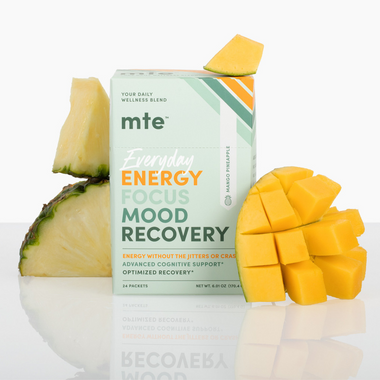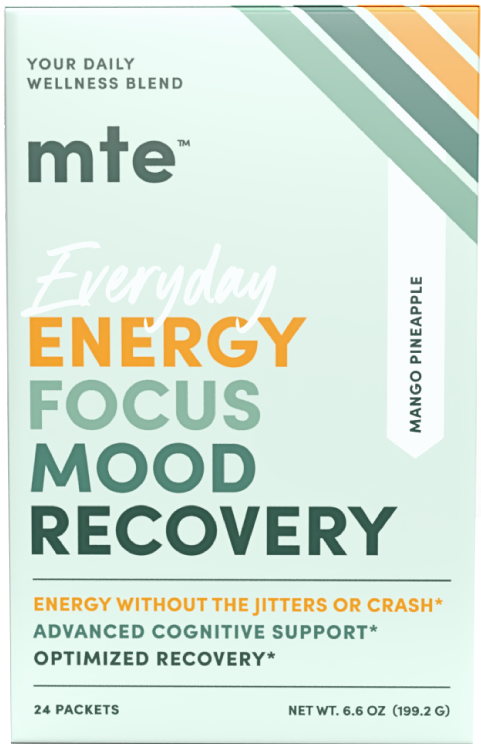
The Evolution of Energy Drinks: From Paleolithic to Post-Modern
Energy drinks. Literally nobody doesn’t know the name Monster® or Redbull®, and most of us know these stimulant-packed energy drinks don’t come without negative symptoms and health risks. And now, those dated products are being replaced by healthy alternatives that use bioactive greens to achieve a clean version of what excessive caffeine promises.
Ironically, these “new” bioactive greens – adaptogens, nootropics and superfoods – aren’t new at all. Many have been used for centuries and sometimes millennia, specifically in energy drinks, tonics and tinctures. What, exactly, is man’s eternal search for the perfect energy boost about? Lots of stuff – but that’s for another article. Or three.
What, exactly is the history of energy drinks? Good news: we did a deep dive and made this handy timeline! You’ll probably be surprised how long the story goes back; and it’s the perfect example of how progress is anything but linear:
The Complete History of Energy Drinks: A Timeline
ATM Energy Tonic – East Africa, 50000+ YPB
Thought to be a part of East African cultures since before we killed all the Neanderthals, The African Traditional Medicine energy tonic is comprised of 6 key ingredients: Uqonsi, Umbhadlangu, Umlunge, Inhluthe, Iklolo, and Umlungumabele. It’s used for everything from immunity to energy to HIV/AIDS, and is currently being explored in clinical settings.
Bush Tea – Australia, 50000+ YPB
The origins of bush tea are thought to coincide with arrival on the Australian continent. Traditional bush tea ingredients include gum trees, bracken fern, Australian blackwood, kangaroo apple, and old man’s weed. Bush teas are used for everything from fatigue to headaches to connecting with the ancestors.
Coca Tea – South America, 6000 BCE
The use of coca in an energy tonic began when people in the Andes discovered it increased their ability to work and exist in those extra-high altitudes. It’s still widely consumed across South America today. Coca tea is considered to be a healthy energy beverage that can reduce altitude sickness, improve cognitive function, boost energy levels, stop headaches, and fight fatigue.
Ashwagandha – Near/Middle East, 4000 BCE
This multitalented adaptogen is first recorded in Ancient Sumer as the vitality drink. In 6000 years of traditional use, it’s been used for fatigue, aging, immunity, fertility, and more. Ashwagandha energy drinks will continue to play a part in energy drink history, and its renaissance is what spurred the body of clinical research to back its bioactivity that we have today.
Ephedra – China, 3000 BCE
Also known as ma huang, ephedra is a plant that contains ephedrine. It’s traditionally used in Chinese medicine for respiratory and circulatory problems, and ephedra energy drinks can boost metabolism and energy levels. Ephedrine is extremely potent, so making a ma huang tea is safer than taking modern products that contain the stimulant.
Betel Nut – Asia/Pacific Islands, 3000 BCE
Most often used as a chew, but also consumed in drink form, betel nut is the seed Areca catechu palm tree. It contains a stimulant called arecoline, which is similar to caffeine in its effects. An herbal energy drink made of betel nut can produce a feeling of energy, alertness and euphoria. And, in fact, betel nut is still a popular stimulant in Asia and the Pacific Islands today.
Gotu Kola – Southeast Asia, 3000 BCE
Better known as Centella asiatica, gotu kola roughly translates to “wisdom leaf”. It is a mood-boosting drink that enhances cognition, gotu kola tea can also reduce stress and anxiety. This herbal energy tonic also supports the circulatory system and reduces inflammation. It’s currently re-emerging in healthy energy drink substitutes.
Green Tea – China, 2737 BCE
Gotta love Ancient China’s meticulous medical texts. Green tea was originally used by emperors and the elite an immunity tonic, energy drink, brain booster, and more. Green tea contains caffeine, a stimulant, and l-theanine, a nootropic that supports mood and stress response by promoting dopaminergic activity in the brain. We’ll see green tea again later – it’s arguably the most consistent presence in the history of energy drinks.
Cannabis Tea – China, 2737 BCE
Weed-laced energy drinks aren’t just a thing of today; they’re a relic. It all started when Emperor Shen Neng prescribed it for the treatment of gout, rheumatism, malaria, and poor memory. Marijuana acts on the endocannabinoid system to enhance feelings of energy, alertness, clarity, and mood, creating a safer, calmer substitute for stimulants. We soon see several other cultures catch on.
Asian Ginseng – China, 2500 BCE
Ginseng is a three-part story that starts in China, where it’s been a part of traditional medicine for well over 4 millennia. It’s an adaptogen that is considered a cure-all, referred to as a “supreme herb”. Ginseng teas are believed to promote physical and mental well-being, boost energy levels, enhance cognitive function, and strengthen the immune system. It’s still used medicinally all over the world.
Kava – Pacific Islands, 1500 BCE
A tea made from the kava kava plant, Pacific Islanders have consumed this mood-elevating drink for at least 3000 years. The roots are chewed, pulped, and then steeped in water. Kava is a relaxation drink, but it’s also a mood tonic – elevating your mood without elevating your anxiety, to bestow an overall sense of clarity and sustained energy.
Cannabis Tea – Egypt, 1500 BCE
Cannabis tea shows up in the Ebers papyrus, an ancient medical text.
Choclatl – Mesoamerica, 1500 BCE
Choclatl is an energizing drink that dates back to the Olmecs, who were the first to cultivate cacao trees. Brewed from cacao beans, which naturally contains caffeine, chocolatl became highly revered by the Mayans, who inherited the Olmec kingdom. Chocolatl is the direct ancestor of modern Mexican hot chocolate and Spanish chocolaté, with later products like Swiss Miss® being the weird second-cousin who eats glue.
American Ginseng – North America, 1000 BCE
Part two of our ginseng story: North American ginseng. Native Americans across the continent have utilized ginseng as a paste, tonic or tea for at least 3000 years (probably more like 5000). It was believed to be a cure-all tonic, used for headaches, stomachaches, and respiratory problems. Ginseng was also used as an energy drink and to improve overall health.
Tobacco Tea – South America, 1000 BCE
Pottery residue indicates that 3000 years before cigarettes, the Guarani of South America used tobacco energy tonics in ceremonial contexts and to treat a variety of ailments. The nicotine in tobacco is what causes the stimulant effect. Plus, nicotine stimulates the brain’s reward center, boosting mood. Though today we know it makes for about the opposite of a healthy natural energy drink.
Tobacco Tea – North America, 0 BCE
Tobacco tea reaches North America via trade.
Acai Berry Tea – South America, 0 BCE
A trendy superfood of the aughts, nobody really knows how to pronounce acai. Regardless, acai tea has long been a key vitality drink in the Amazon region. Acai berry tea is used for a variety of ailments and is thought to be an aphrodisiac. People drink it to boost mood, energy, wellness, and improve the immune system.
Rhodiola Rosea – Greece, 77 CE
Another culture great at record-keeping – the first mention of Rhodiola rosea comes from Dioscordes’ 1st century medical text. This adaptogenic root is packed with bioactive compounds that perform a variety of functions. Energy drinks with Rhodiola rosea promote dopamine and serotonin, producing a stress-reducing + mood-boosting effect.
Cannabis Tea – Europe – 400 CE
Cannabis tea is used as a popular remedy for a variety of ailments, including arthritis, fatigue, nausea, and appetite. It continues to be a popular immunity tonic through the Middle Ages.
Rhodiola Rosea – Scandinavia, 900 CE
Rhodiola rosea has been a part of traditional medicine in Russian and Scandinavia for at least a millennium, and is actually a part of modern clinical medicine throughout Northern Europe today. This immunity and energy-enhancing tonic is used for a wide variety of problems, including fatigue, depression and nervous system disorders. It is also thought to increase physical endurance.
Coffee – Ethiopia, 1200 CE
In legend, coffee was first discovered by a goat herder named Kaldi, who discovered the energizing effects of coffee berries after observing his goats become livelier after consuming them. Coffee then goes on an epic journey, where we see it eventually become the world’s favorite natural energy drink. Along with tea, of course.
Coffee – Yemen, 1400 CE
Coffee cultivation, trade and use spreads across the Red Sea in to Yemen and the Arab Peninsula.
Green Tea – Europe, 1500 CE
Green tea reaches Europe via imperialism.
Tobacco Tea – Europe, 1500 CE
Tobacco tea reaches Europe via imperialism.
Coffee – Middle East/North Africa, 1500 CE
Coffee comes to Persia, Egypt, Syria, and Turkey, where it’s used mainly as a social lubricant for its mood-enhancing and energy-boosting benefits.
Asian Ginseng – Europe, 1600 CE
Asian ginseng arrives in Europe via trade.
Coffee – Europe, 1600 CE
Coffee reaches Europe via imperialism, where it’s initially fought by religious leaders (surprise) who were afraid of the stimulating effects of this plant-sourced energy drink.
Black Tea – China, 1650 CE
Black tea is believed to have originated in China in the mid-17th century, when tea producers accidentally oxidized tea leaves, resulting in a darker, more flavorful brew. Used similarly to green tea, black tea is now a favorite go-to herbal drink for boosting energy, alertness and mood. After its inception, we see black tea spread worldwide in the matter of a century.
Green Tea – North America, 1700 CE
Green tea reaches the Americas via imperialism.
Coffee – North/South America, 1700 CE
Coffee arrives in the Americas via imperialism, where it is cultivated in South and Central America. It’s officially a worldwide commodity which, as we all know, holds true to this day.
Black Tea – Europe/North America, 1700 CE
Black tea spreads to the West via imperialism
Ephedra – China, 1885 CE
Ma huang re-emerges as a potent stimulant for energy-boosting drinks in the late 19th century when amphetamines become a thing. In a few decades, we’ll see where this whole thing kind of went off the rails… Actually, in the history of energy drinks, you could say this is the point where things started to fall apart.
Coca Cola – US, 1886 CE
Case-in-point: the famous coke-laced Coke! This one’s pretty self-explanatory, and until the early 20th century, Coca-Cola was accidentally boosting the hell out of everybody’s energy levels with this not-so-healthy energy drink.
Radium Energy Tonics – US, 1918 CE
Radioactive energy drinks? What an apt metaphor for a beverage that will literally melt your face off. The most popular radium energy drink was RadiThor, which was marketed for ailments like impotence, arthritis and fatigue. But then radiation poisoning melted people’s teeth and bones, and RadiThor – and all radium consumables – quickly die out.
Ephedrine – Romania, 1927 CE
When ephedrine is synthesized, the amphetamine snowball begins. Initially used as an energy drink and fatigue-reducer, ephedrine is eventually used for depression, obesity, ADHD, and more.
Ephedrine – US, 1940 CE
Ephedrine energy drinks are given to soldiers in WWII to keep them awake and alert.
Cannabis Tea – US, 1960 CE
Cannabis tea becomes popular among young adults in the US during that hippie phase we had.
Modern Energy Drinks – Japan, 1962 CE
The first commercially successful energy drink in modern history, Lipovitan-D, was introduced by the Taisho Pharmaceutical Company in 1962. Lipovitan-D was an energy shot that contained 50 milligrams of caffeine, 1,000 milligrams of taurine, various B vitamins, and flavorings. Marketed for fatigue and concentration, this new concept of energy drinks quickly spreads to other parts of Asia, and by the 1980s, they begin to gain popularity in North America.
Ma’sud – Somali Diaspora, 1970 CE
Also known as khat tea, this little shrub was used as a chew across the Middle East for centuries. However, it wasn’t until the ‘70s that people began to experience with khat in liquid form. It’s utilized to induce a state of euphoria, alertness, and increased energy. Today, the WHO classifies khat as a stimulant, and warns against khat energy drinks potential for dependence and addiction.
Krating Daeng – Thailand, 1976 CE
A non-descript, super-high caffeine and taurine energy drink, this is the direct precursor to the OG Red Bull®. An Austrian businessman drank it to cure his jet lag, and then partnered with a Thai company to create a version of it that Westerners would like.
Kava – Australia, 1980 CE
Kava begins to become a popular natural energy drink with non-indigenous Australians for its ability to boost energy without any nasty side effects. Only took a few thousand years…
Modern Energy Drinks, North America, 1985 CE
Jolt Cola becomes the first energy drink to be widely available in the United States. Jolt was known for its high caffeine content (2x that of Coke and Pepsi at the time) and its slogan, "All the taste, all the power."
Red Bull® – US, 1987
Red Bull® – and energy drinks as we know it – arrive in the US. And the spiral into excessive caffeine reliance truly begins… A can of Red Bull® has 248mg of caffeine in it, which is roughly equivalent to 2.5 cups of coffee. Taurine, sugar and B vitamins round out the energy-boosting blend in America’s OG stimulant drink. Not great.
Ephedrine – North America/Europe, 1990 CE
In the 1960s, recreational ephedrine use emerges, and then things get weird, because amphetamines. By the ‘70s the dangers were finally recognized, and by the ‘90s it is banned in dietary supplements – including energy drinks.
NOS® – US, 1997 CE
NOS® launches their energy drink, marketed mainly for motorsports and clocking in at 160mg caffeine and an undisclosed amount of guarana and taurine.
LSD Tinctures – US, 2000 CE
Hallucinogens are beginning to be utilized for psychological and cognitive problems like depression, anxiety, sleep disorders, and paranoia. Microdosing with LSD in a tincture or mixed in a drink is thought to enhance creativity, focus, and problem-solving abilities. However, it is important to note that LSD is still a Schedule I drug in the US and has a high potential for abuse.
Rockstar Energy® – US, 2001 CE
Now one of the top names in the mainstream energy drink game, Rockstar® energy drinks are particularly popular with young adults. One can contains 160mg of caffeine and a whopping 63g of sugar – twice as much as the daily recommended amount.
Monster Energy® – US, 2002 CE
Monster® launches their first energy drink, which also contains a diabetes-inducing amount of sugar – 57g. Caffeine content is 160mg. It quickly becomes popular among young adults and athletes.
5-Hour Energy® – US, 2004 CE
5-Hour Energy® releases their namesake energy shot, containing 200mg of caffeine! Their new extra-strength one contains even more. Jitters and cold sweats, anyone? This mini-energy drink has become ubiquitous at gas stations all over the country.
Venom® – US, 2007 CE
Particularly popular with underground culture, Venom®’s energy formula contains 160mg of caffeine and A LOT of taurine, guarana, L-carnitine, ginseng and B vitamins for a kick-in-the-pants energy boost. …At least there’s ginseng?
Bang! Energy® – US, 2012 CE
Bang!® was created by Vital Pharmaceuticals, Inc., a company that also produces sports supplements and performance beverages. Bang! Energy Drink® is marketed as low-sugar and high-performance. One can of this high-caffeine energy drink contains a heart-stopping 300mg of caffeine (400mg is the daily safety limit), supported by amino acids, CoQ10 and creatine.
Ashwagandha, Etc. – Europe/US, 2014 CE
Ashwagandha’s back, baby! And better than ever. Modern tech has made it possible to take clean, concentrated extracts that allow a huge amount of this amazing adaptogen to be packed into a convenient energy drink powder.
Ashwagandha is one of the main herbs that has helped the alternative energy drink market grab a foothold in the business. And along with it, a bunch of other ancient energizing herbs came out of the woodwork, like ginseng, eleuthero, maca, and gotu kola. You get all the benefits of stimulants (and much more) without the negative side effects.
MTE – US, 2022 CE
In the history of energy drinks, MTE (More Than Energy) jumps off the timeline and into a future of a different kind of energy. Ephedra, caffeine, cocaine? No way. Green tea, adaptogens and nootropics? Heck yes. Launched in 2022, this energy supplement supports comprehensive well-being, boosting energy by hacking your body back into balance. This allows you to experience innate energy instead of requiring stimulants to be alert and focused.
Present-Day Energy Drinks & the Switch from Stimulants
Call it a post-modern energy drink movement. We’ve kicked the need for sketchy stimulants like caffeine, taurine, creepy chemicals, and sugar bombs. And why would we use that stuff when we have safe, healthy alternatives to caffeine and sugar, like adaptogens and nootropics?Today, we have the technology, the knowledge, the clinical literature to back a new kind of energy drink, focused on systemic wellness and optimizing the body’s natural energy production. Which is exactly what we set out to do with our daily green energy drink powder. And if you’re interest has been piqued, you can learn more about MTE®, energy drinks, the new wave of herbal mood and energy beverages, and more on our Wellness Blog.






